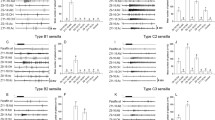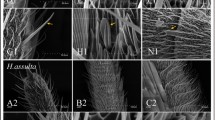Abstract
This study examined electrophysiological responses of the Australian budworm moth Helicoverpa punctigera, to heliothine sex pheromone components, via single sensillum recordings (SSR), and examined male neuroanatomy using confocal microscopy and 3D imaging tools. We found that male H. punctigera have three distinct regions of the macroglomerular complex (MGC) in the antennal lobe. Male antennae have only two functional types of sensilla trichoidea (A and C) and type A sensilla contain an olfactory sensory neuron (OSN) that responds to the major sex pheromone component (Z)-11-hexadecenal (Z11-16:Ald) with axons projecting to the cumulus of the macroglomerular complex (MGC) in the antennal lobe. Type C sensilla contained large-spiking receptor neurons which responded primarily to (Z)-9-tetradecenal (Z9-14:Ald) and to a lesser degree to (Z)-11-hexadecenol (Z11-16:OH). These were co-compartmentalized with small-spiking receptor neurons in type C sensilla which responded strongly to Z9-14:Ald and (Z)-9-hexadecenal (Z9-16:Ald), and to a lesser degree to (Z)-11-hexadecenyl acetate (Z11-16:OAc) and Z11-16:OH. Axons from the two co-localized neurons in Type C sensilla projected to the two small MGC units, the dorsomedial anterior and dorsomedial posterior, respectively. In wind tunnel assays, the addition of Z9-16:Ald to an otherwise attractive blend completely shut down male H. punctigera upwind flight.







Similar content being viewed by others
Abbreviations
- AL:
-
Antennal lobe
- Cu:
-
Cumulus
- D:
-
Dorsal
- DMA:
-
Dorsomedial anterior
- DMP:
-
Dorsomedial posterior
- MGC:
-
Macroglomerular complex
- OSN:
-
Olfactory sensory neuron
- SSR:
-
Single sensillum recording
- V:
-
Ventral
- Z9-16Ald:
-
(Z)-9-Hexadecenal
- Z11-16Ald:
-
(Z)-11-Hexadecenal
- Z11-16OAc:
-
(Z)-11-Hexadecenyl acetate
- Z11-16OH:
-
(Z)-11-Hexadecenol
- Z9-14Ald:
-
(Z)-9-Tetradecenal
References
Baker TC, Quero C, Vickers NJ (2006) Inheritance of olfactory preferences II. Olfactory receptor neuron responses from Heliothis subflexa × Heliothis virescens hybrid male moths. Brain BehavEvol 68(2):75–89
Berg BG, Mustaparta H (1995) The significance of major pheromone components and interspecific signals as expressed by receptor neurons in the oriental tobacco budworm moth, Helicoverpa assulta. J Comp Physiol A 177:683–694
Berg BG, Almaas T, Bjaalie J, Mustaparta H (1998) Themacroglomerular complex of the antennal lobe in the tobacco budworm moth Heliothis virescens: specified subdivision in four compartments according to information about biologically significant compounds. J Comp Physiol 183:669–682
Berg BG, Galizia CG, Brandt R, Mustaparta H (2002) Digital atlases of the antennal lobe in two species of tobacco budworm moths, the oriental Helicoverpa assulta (male) and the American Heliothis virescens (male and female). J Comp Neurol 446(2):123–134
Berg BG, Almaas TJ, Bjaalie JG, Mustaparta H (2005) Projections of male-specific receptor neurons in the antennal lobe of the oriental tobacco budworm moth, Helicoverpa assulta: a unique glomerular organization among related species. J Comp Neurol 486(3):209–220
Berg BG, Zhao XC, Wang G (2014) Processing of pheromone information in related species of heliothine moths. Insects 5:742–761
Boeckh J, Tolbert LP (1993) Synaptic organization and development of the antennal lobe in insects. Microsc Res Technol 24(3):260–280
Chang H, Ai D, Zhang J, Dong S, Liu Y, Wang G (2017) Candidate odorant binding proteins and chemosensory proteins in the larval chemosensory tissues of two closely related noctuidae moths, Helicoverpa armigera and Helicoverpa assulta. PLoS One 12(6):1–19
Cork A, Boo KS, Dunkelblum E, Hall DR, Jee-Rajunga K, Kehat M, Kong JIEE, Park KC, Tepgidagarn P, Xun L (1992) Female sex pheromone of oriental tobacco budworm, Helicoverpa assulta (Guenee) (Lepidoptera: Noctuidae): identification and field testing. J ChemEcol 18:403–418
Cossé A, Todd J, Baker TC (1998) Neurons discovered in male Helicoverpa zea antennae that correlate with pheromone-mediated attraction and interspecific antagonism. J Comp Physiol A 182(5):585–594
Czepak C, Albernaz KC, Vivan LM, Guimarães HO, Carvalhais T (2013) First reported occurrence of Helicoverpa armigera (Hübner) (Lepidoptera: Noctuidae) in Brazil. PesquisaAgropecuária Tropical 43(1):110–113
Dunkelblum E, Gothilf S, Kehat M (1980) Identification of the sex pheromone of the cotton bollworm, Heliothis armigera. Israel Phytoparasitica 8(3):209–211
Fadamiro HY, Baker TC (1997) Helicoverpa zea males (Lepidoptera: Noctuidae) respond to the intermittent fine structure of their sex pheromone plume and an antagonist in a flight tunnel. PhysiolEntomol 22(4):316–324
Gothilf S, Kehat M, Jacobson M, Galun R (1978) Sex attractants for male Heliothis armigera (Hbn.). Experientia 34(7):853–854
Gould F, Estock M, Hillier NK, Powell B, Groot AT, Ward CM, Emerson JL, Schal C, Vickers NJ (2010) Sexual isolation of male moths explained by a single pheromone response QTL containing four receptor genes. ProcNatlAcadSci 107:8660–8665
Große-Wilde E, Gohl T, Bouché E, Breer H, Krieger J (2007) Candidate pheromone receptors provide the basis for the response of distinct antennal neurons to pheromonal compounds. Eur J Neurosci 25:2364–2373
Hildebrand JG, Shepherd GM (1997) Mechanisms of olfactory discrimination: converging evidence for common principles across phyla. Ann Rev Neurosci 20(1):595–631
Hillier NK, Baker TC (2016) Pheromones of heliothine moths. In: Allison JD, Cardé RT (eds) Pheromone communication in moths—evolution, behavior, and application. University of California Press, California, pp 301–333
Hillier NK, Kavanagh RM (2015) Differential octopaminergic modulation of olfactory receptor neuron responses to sex pheromones in Heliothis virescens. PLoS One 10(12):e0143179
Hughes GP, Cardé RT (2020) Do Helicoverpa armigera moths signal their fecundity by emission of an antagonist? J Chem Ecol 46:21–29
Kehat M, Dunkelblum E (1990) Behavioral responses of male Heliothis armigera moths in a flight tunnel to combinations of components identified from female sex pheromone glands. J Insect Behav 3:75–83
Klun J, Plimmer J, Bierl-Leonhardt B, Sparks A, Primiani M, Chapman O, Lee G, Lepone G (1980) Sex pheromone chemistry of female corn earworm moth Heliothis zea. J Chem Ecol 6(1):165–175
Krieger J, Gondesen I, Forstner M, Gohl T, Dewer Y, Breer H (2009) HR11 and HR13 receptor-expressing neurons are housed together in pheromone-responsive sensillatrichodea of male Heliothis virescens. Chem Senses 34:469–477
Lee SG, Carlsson MA, Hansson BS, Todd JL, Baker TC (2006) Antennal lobe projection destinations of Helicoverpa zea male olfactory receptor neurons responsive to heliothine sex pheromone components. J Comp Physiol A 192(4):351–363
Lee SG, Vickers NJ, Baker TC (2006) Glomerular targets of Heliothis subflexa male olfactory receptor neurons housed within long trichoidsensilla. Chem Senses 31(9):821–834
Lelito JP, Myrick AJ, Baker TC (2008) Interspecific pheromone-plume interference among sympatric heliothine moths: a wind tunnel test using live, calling females. J Chem Ecol 34:725–733
Liu Y, Liu C, Lin K, Wang G (2013) Functional specificity of sex pheromone receptors in the cotton bollworm Helicoverpa armigera. PLoS One 8(4):e62094
Piccardi P, Capizzi A, Cassani G, Spinelli P, Arsura E, Massardo P (1977) A sex pheromone component of the Old World bollworm Heliothis armigera. J Insect Physiol 23(11–12):1443–1445
Roelofs WL, Hill AS, Cardé RT, Baker TC (1974) Two sex pheromone components of the tobacco budworm moth Heliothis virescens. Life Sci 14(8):1555–1562
Rothschild G (1978) Attractants for Heliothis armigera and Helicoverpa punctigera. J AustEntomolSoc 17:389–390
Rothschild G, Nesbitt B, Beevor P, Cork A, Hall D, Vickers R (1982) Studies of the female sex pheromone of the native budworm, Heliothis punctigera. EntomolExpAppl 31(4):395–401
Skiri HT, Ro H, Berg BG, Mustaparta H (2005) Consistent organization of glomeruli in the antennal lobes of related species of heliothine moths. J Comp Neurol 491:367–380
Tay WT, Soria MF, Walsh T, Thomazoni D, Silvie P, Behere GT, Anderson C, Downes S (2013) A brave new world for an old world pest: Helicoverpa armigera (Lepidoptera: Noctuidae) in Brazil. PLoS One 8(11):e80134
Vásquez GM, Syed Z, Estes PA, Leal WS, Gould F, Jurenka R (2013) Specificity of the receptor for the major sex pheromone component in Heliothis virescens. J Insect Sci 13(1):160
Vickers NJ (2006a) Inheritance of olfactory preferences I. Pheromone-mediated behavioral responses of Heliothis subflexa × Heliothis virescens hybrid male moths. Brain BehavEvol 68(2):63–74
Vickers NJ (2006b) Inheritance of olfactory preferences III. Processing of pheromonal signals in the antennal lobe of Heliothis subflexa × Heliothis virescens hybrid male moths. Brain BehavEvol 68(2):90–108
Vickers NJ, Baker T (1997) Chemical communication in heliothine moths. Vii. Correlation between diminished responses to point-source plumes and single filaments similarly tainted with a behavioral antagonist. J Comp Physiol A 180:523–536
Vickers NJ, Christensen T, Hildebrand J (1998) Combinatorial odor discrimination in the brain: attractive and antagonist odor blends are represented in distinct combinations of uniquely identifiable glomeruli. J Comp Neurol 400(1):35–56
Wang G, Vásquez GM, Schal C, Zwiebel LJ, Gould F (2011) Functional characterization of pheromone receptors in the tobacco budworm Heliothis virescens. Insect MolBiol 20(1):125–133
Watanabe H, Haupt SS, Nishino H, Nishikawa M, Yokohari F (2012) Sensillum-specific, topographic projection patterns of olfactory receptor neurons in the antennal lobe of the cockroach Periplaneta americana. J Comp Neurol 520(8):1687–1701
Wu H, Hou C, Huang LQ, Yan FS, Wang CZ (2013) Peripheral coding of sex pheromone blends with reverse ratios in two Helicoverpa species. PLoS One 8(7):e70078
Xu M, Guo H, Hou C, Wu H, Huang LQ, Wang CZ (2016) Olfactory perception and behavioral effects of sex pheromone gland components in Helicoverpa armigera and Helicoverpa assulta. Sci Rep 6(1):1–14
Zhang JP, Salcedo C, Fang YL, Zhang RL, Zhang ZN (2012) An overlooked component: (Z)-9-tetradecenal as a sex pheromone in Helicoverpa armigera. J InsPhysiol 58:1209–1216
Zhao XC, Berg BG (2010) Arrangement of output information from the 3 macroglomerular units in the heliothine moth Helicoverpa assulta: morphological and physiological features of male-specific projection neurons. Chem Senses 35(6):511–521
Zhao XC, Chen QY, Guo P, Xie GY, Tang QB, Guo XR, Berg BG (2016) Glomerular identification in the antennal lobe of the male moth Helicoverpa armigera. J Comp Neurol 524(15):2993–3013
Acknowledgements
We acknowledge the financial support of the Natural Sciences and Engineering Research Council of Canada (RGPIN-2017-04319 to NKH), Canada Foundation for Innovation (22087 to NKH) and the Agriculture and Agri-Food Canada Agricultural Youth Green Jobs Initiative. All authors declare that they have no competing interests. This study followed all applicable national and institutional guidelines for animal care and experimentation.
Author information
Authors and Affiliations
Corresponding author
Additional information
Publisher's Note
Springer Nature remains neutral with regard to jurisdictional claims in published maps and institutional affiliations.
Rights and permissions
About this article
Cite this article
Cloonan, K., Rizzato, A.R., Ferguson, L. et al. Detection of heliothine sex pheromone components in the Australian budworm moth, Helicoverpa punctigera: electrophysiology, neuroanatomy, and behavior. J Comp Physiol A 206, 939–950 (2020). https://doi.org/10.1007/s00359-020-01450-6
Received:
Revised:
Accepted:
Published:
Issue Date:
DOI: https://doi.org/10.1007/s00359-020-01450-6




